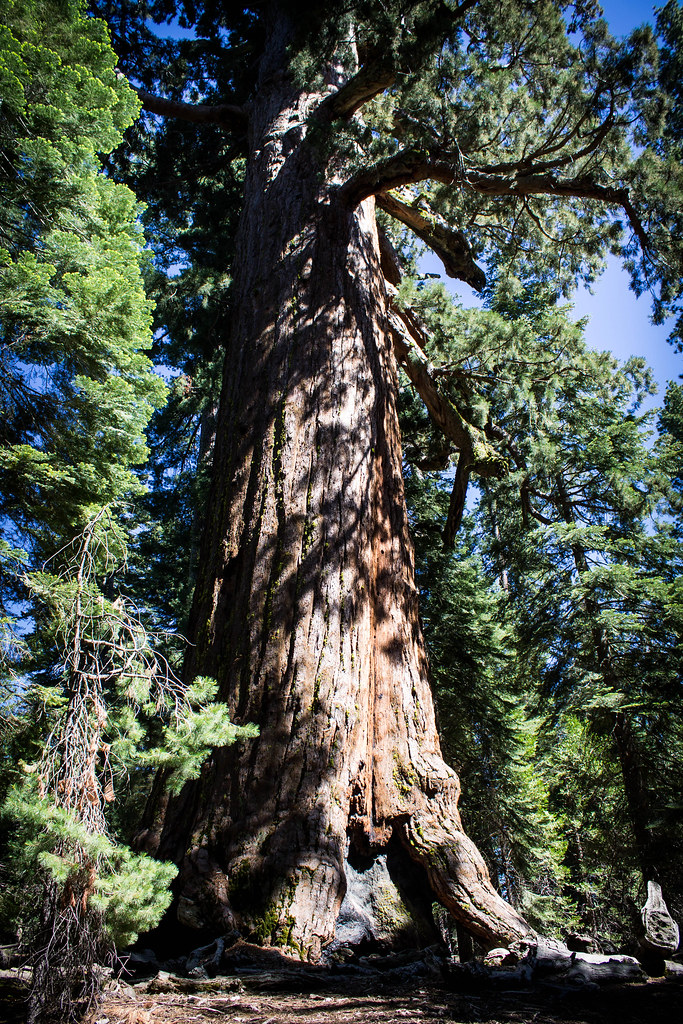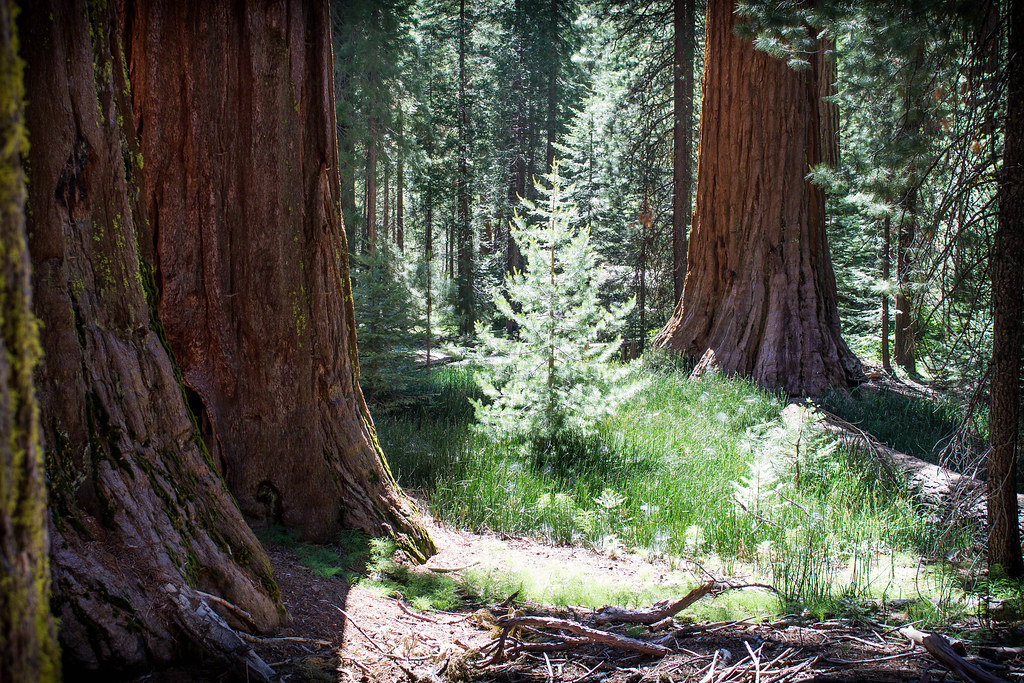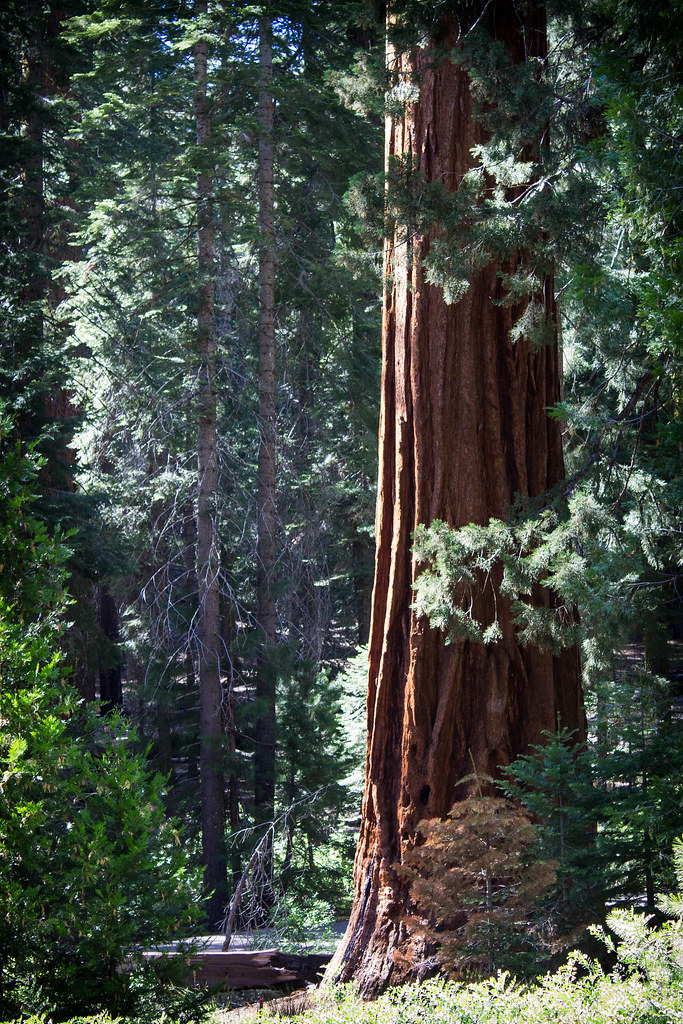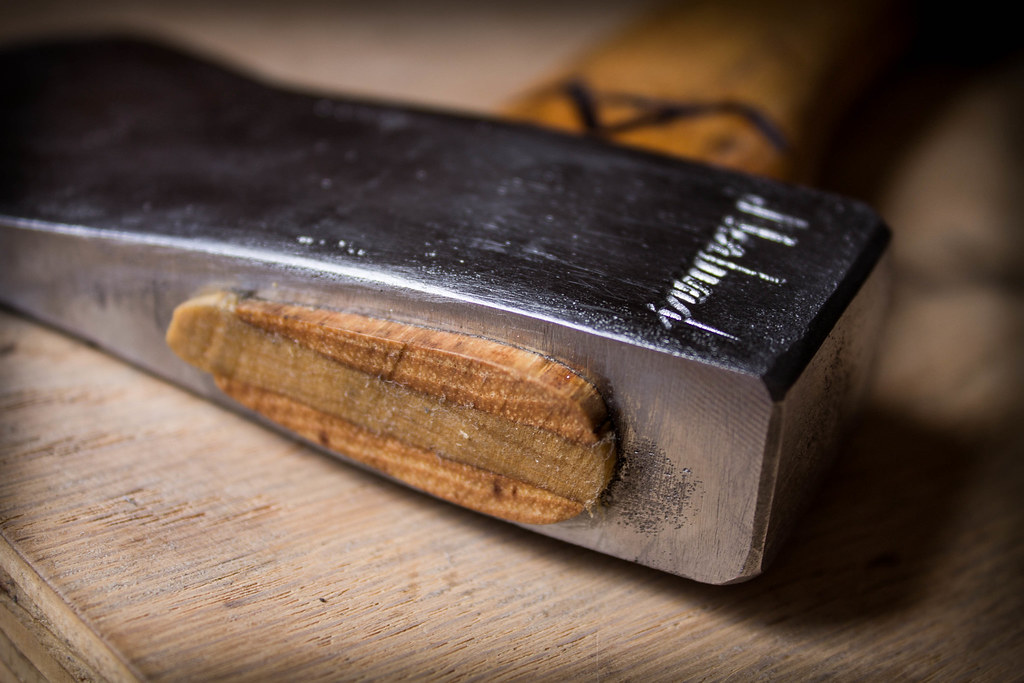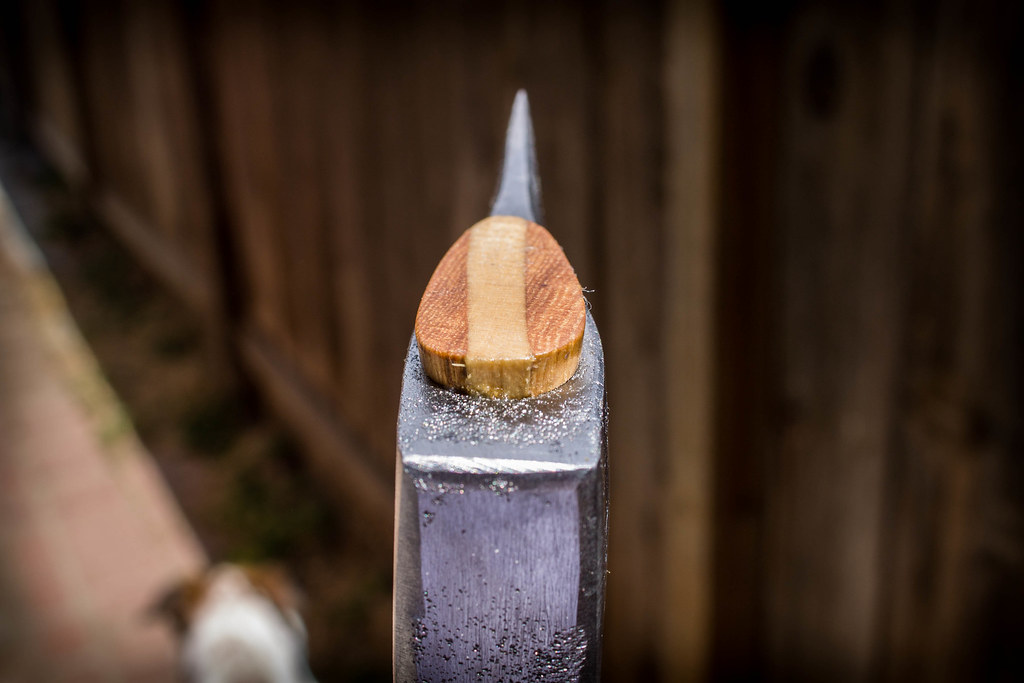Finished this one today. W.C. Kelley Perfect Jersey Patterned Axe.
Coulda worked over the sharpening some more, but it was 100 degrees on its way to 109. So I called it done for now.
Sunday, June 30, 2013
Tuesday, June 25, 2013
Little Trip to the Big Trees
Last weekend the wife and I took our boy up to the Mariposa
Grove of Giant Sequoias in Yosemite . This grove of big trees was one of the first set aside for reservation from the timber industry. President Lincoln first reserved it and Yosemite Valley, and gave it over to the state to protect. Later on in 1906, the state turned it back over to the federal government, and with convincing from John Muir, President Roosevelt designated the grove and the valley into a much larger Yosemite National Park.
President Roosevelt visited the grove and other areas of the park with John Muir as a guide in 1903. They stayed the night in the grove, sleeping under piles of army blankets, and conversing over the campfire. Roosevelt had this to say about the experience:
"The night was clear, and in the darkening isles of the great sequoia grove, the majestic trunks, beautiful in color and symetry, rose around us like the pilars of the mightiest cathedral that ever was concieved, even by the fervor of the Middle Ages. Hermit thrushes sang beautifully in the evening."
My wife and I had never been to this grove, so we joined the throngs of fellow tourists, and entered Yosemite.
Early on in Muir's travels through the Sierra, he would write letters to friends to describe what he has witnessed. From a letter to Mrs. Ezra Carr
which Muir wrote with the sap of a Sequoia:
"Do behold the King in his glory,
King Sequoia! Behold! Behold! seems all I can say Some time ago I left all for
Sequoia and have been and am at his feet; fasting and praying for light, for is
he not the greatest light in the woods, in the world? Where are such columns of
sunshine, tangible, accessible, terrestrialised? Well may I fast, not from
bread, but from business, book-making, duty-going, and other trifles, and great
is my reward already for tbe manly, freely sacrifice. What giant truths since
coming to Gigantea, what magnificent clusters of Sequoiac becauses.
The King tree and I have sworn
eternal love—sworn it without swearing, and I’ve taken the sacrament with
Douglas squirrel, drunk Sequoia wine, Sequoia blood, and with its rosy purple
drops I am writing this woody gospel letter.
I never before knew the virtue of
Sequoia juice. Seen with sunbeams in it, its color is the most royal of all
royal purples. No wonder the Indians instinctively drink it for they know not
what. I wish I were so drunk and Sequoical that I could preach the green brown
woods to all the juiceless world, descending from this divine wilderness like a
John the Baptist, eating Douglas squirrels and wild honey or wild anything,
crying, Repent, for the Kingdom of Sequoia is at hand!"
While Muir's earlier letter may have been a little over the top poetically, later in 1912 he wrote "The Yosemite". In it, he describes the giants a little more technically. Here is an excerpt:
"Between the heavy pine and silver fir zones towers the Big Tree (Sequoia
gigantea), the king of all the conifers in the world, “the noblest of the
noble race.”
So harmonious and finely balanced
are even the mightiest of these monarchs in all their proportions that there is
never anything overgrown or monstrous about them. Seeing them for the first
time you are more impressed with their beauty than their size, their grandeur
being in great part invisible; but sooner or later it becomes manifest to the
loving eye, stealing slowly on the senses like the grandeur of Niagara or of
the Yosemite Domes. When you approach them and walk around them you begin to
wonder at their colossal size and try to measure them. They bulge considerably
at the base, but not more than is required for beauty and safety and the only
reason that this bulging seems in some cases excessive is that only a comparatively
small section is seen in near views. One that I measured in the Kings River forest was twenty-five feet in diameter at
the ground and ten feet in diameter 220 feet above the ground showing the
fineness of the taper of the trunk as a whole. No description can give anything
like an adequate idea of their singular majesty, much less of their beauty.
Except the sugar pine, most of their neighbors with pointed tops seem ever
trying to go higher, while the big tree, soaring above them all, seems
satisfied. Its grand domed head seems to be poised about as lightly as a cloud,
giving no impression of seeking to rise higher. Only when it is young does it
show like other conifers a heavenward yearning, sharply aspiring with a long
quick-growing top. Indeed, the whole tree for the first century or two, or
until it is a hundred or one hundred and fifty feet high, is arrowhead in form,
and, compared with the solemn rigidity of age, seems as sensitive to the wind
as a squirrel’s tail. As it grows older, the lower branches are gradually
dropped and the upper ones thinned out until comparatively few are left. These,
however, are developed to a great size, divide again and again and terminate in
bossy, rounded masses of leafy branch-lets, while the head becomes dome-shaped,
and is the first to feel the touch of the rosy beams of the morning, the last
to bid the sun good night. Perfect specimens, unhurt by running fires or
lightning, are singularly regular and symmetrical in general form though not in
the least conventionalized, for they show extraordinary variety in the unity
and harmony of their general outline. The immensely strong, stately shafts are
free of limbs for one hundred end fifty feet or so The large limbs reach out
with equal boldness a every direction, showing no weather side, and no other
tree has foliage so densely massed, so finely molded in outline and so
perfectly subordinate to an ideal type. A particularly knotty, angular,
ungovernable-looking branch, from five to seven or eight feet in diameter and
perhaps a thousand years old, may occasionally be seen pushing out from the
trunk as if determined to break across the bounds of the regular curve, but
like all the others it dissolves in bosses of branchlets and sprays as soon as
the general outline is approached. Except in picturesque old age, after being
struck by lightning or broken by thousands of snow-storms, the regularity of
forms is one of their most distinguishing characteristics. Another is the
simple beauty of the trunk and its great thickness as compared with its height
and the width of the branches, which makes them look more like finely modeled
and sculptured architectural columns than the stems of trees, while the great
limbs look like rafters, supporting the magnificent dome-head. But though so consummately
beautiful, the big tree always seems unfamiliar, with peculiar physiognomy,
awfully solemn and earnest; yet with all its strangeness it impresses us as
being more at home than any of its neighbors, holding the best right to the
ground as the oldest strongest inhabitant. One soon becomes acquainted with new
species of pine and fir and spruce as with friendly people, shaking their
outstretched branches like shaking hands and fondling their little ones, while
the venerable aboriginal sequoia, ancient of other days, keeps you at a
distance, looking as strange in aspect and behavior among its neighbor trees as
would the mastodon among the homely bears and deers. Only the Sierra juniper is
at all like it, standing rigid and unconquerable on glacier pavements for
thousands of years, grim and silent, with an air of antiquity about as
pronounced as that of the sequoia.
Mini Pocket Axe
Picked up this mini Norlund Hatchet from a local antique store a while back.
A note said it used to be owned by some rancher named Archer. Well that rancher had taken about an inch off the lower end of the bit!
I kinda liked that though. He also made a useable belt sheath for it. And since I've been drooling over the Gransfors Bruks Mini for a while, I thought I would pick this up for a small fraction of the cost. Luckily I was able to rehaft the original handle which is thinned out nicely. So this one comes in at 1lb 1oz with a 10 1/2" handle and with a 2 1/8" bit. A little smaller than the GB.
Horace Kephart was a fan of the mini hatchet as well. In his masterpiece "Camping and Woodcraft" he has this to say:
"Among my most valued possessions is a tiny Colclesser tomahawk, of 8-ounce head and 2 1/2 inch bit, which, with hickory handle and home-made sheath, weighs only three-quarters of a pound. I seldom go anywhere in the woods (unless in marching order with a heavier axe) without this little trick. It is all that is needed to put up a satisfactory shelter wherever there is hemlock or balsam, or bark that will peel, while for other service I use it oftener than I do my jackknife."
A note said it used to be owned by some rancher named Archer. Well that rancher had taken about an inch off the lower end of the bit!
I kinda liked that though. He also made a useable belt sheath for it. And since I've been drooling over the Gransfors Bruks Mini for a while, I thought I would pick this up for a small fraction of the cost. Luckily I was able to rehaft the original handle which is thinned out nicely. So this one comes in at 1lb 1oz with a 10 1/2" handle and with a 2 1/8" bit. A little smaller than the GB.
Horace Kephart was a fan of the mini hatchet as well. In his masterpiece "Camping and Woodcraft" he has this to say:
"Among my most valued possessions is a tiny Colclesser tomahawk, of 8-ounce head and 2 1/2 inch bit, which, with hickory handle and home-made sheath, weighs only three-quarters of a pound. I seldom go anywhere in the woods (unless in marching order with a heavier axe) without this little trick. It is all that is needed to put up a satisfactory shelter wherever there is hemlock or balsam, or bark that will peel, while for other service I use it oftener than I do my jackknife."
Thursday, June 13, 2013
The Sierra Monsoon
Crackling grasses outside the shade of the live oaks.
Not with flame, but you can hear it sizzle in the hot breeze.
Already dry, but now moving towards the dust under foot.
Standing upright, but drooping when pushed.
Parched fibers bursting the heart within.
Quickly waiting with anticipation but only to fall short.
Just cooking in the hot breath as the summer days roll on.
Eventually to give in and lay over.
The lucky ones get to send off their young to jab through fur and socks.
The vapors overhead gathering high.
Frying in the sky's blue skillet like bacon.
Sizzling and crackling into wisps then gone.
Much too hot to form rain.
Gathering from the east, but not over the plains.
Great anvils of white with gray undertones rise from the depths of the desert.
To gather on the ridges and high passes.
Building higher until relinquishing to the hammer's blow.
Only to shift and rise again beyond the blacksmith's keen eye for a moment.
Filling the sky like the frothing of a giant seashore.
Waves breaking on the beach reaching to greet them.
Then spreading out on the sand with a slow roll.
Water flowing uphill in wide swaths.
Until gravity pulls them back.
Underneath, the clams know what is next.
Sudden piercing like daggers to the heart crackle on the electric air.
Molecules of friction entering unannounced.
Darkness shown in the shadows of hills and creases.
The dry grasses shimmer in the blinding light of the frustration that builds.
White with the rage of a hundred lives crushed at once.
Roadrunners and hares scurry for cover, as the shouting continues.
A rain of shame and blame forces itself upon the dust.
Water split apart with brute strength.
The wind slowly dies down.
The rain is left all alone to begin the healing.
The clouds begin to slowly scatter ashamed for their gathering.
But the darkness stays.
Along with the grasses, to live another day.
The monsoon season is upon us.
Storms from the south to cause heartache.
Just enough to bring grief which luckily can be healed.
Some grasses singed at the fringes from the beating.
But they will be back with their green shine again with time.
To blow in the cool breeze.
And to have sunlight bathe them with warmth.
To expose their inner structure to their shadows.
Saturday, June 1, 2013
My First Hatchet Hafting
Last fall I picked up a few hatchets from a local antique store. The one on the
far right in the picture would be my first adventure into axe refurbishing and
restoration. I chose it because it was the rustiest head and the handle was the
junkiest out of my collection. So I wanted a challenge. Now there's 1001 ways to
do this, but this is the path I chose. Big thanks to all the axeperts for
showin' the ways.
So first up was to remove that junky handle and toss it. I had picked up a link handle for this job. For the next step I soaked the head in white vinegar for a day and eventually gave it an apple cider vinegar soak for about 3 more days.
After the soak, a little scotchbrite rub to get the rust off revealed a partial makers mark stamping. To my great surprise, it turned out to be an American Axe and Tool Co. Americanaxe manufactured in Glassport, PA! Probably forged in the 19-teens, and no later than 1921. Needless to say I was thrilled!
I continued the cleanup with flap wheel and wire brush wheel drill attachments. That wire brush wheel really shined up the metal. The head was pretty pitted out from the rust, but very tiny pits. So pitted in fact that after cleaning it up, the tempering line is easily seen.
Shaped up the mushroomed poll with a file.
The new Link handle I picked up at the local hardware store was covered in a thick laquer. So after sanding all that off, I gave it a quick rub down coating of tung oil. Four coats is what this one called for.
So this morning I finally decided to finish this thing. First had to fit the head to the handle. Did a little shaping and rasping with a four-in-hand.
Sharpened the bit. Started with a Lansky Puck followed by an old sharpening stone. Wasn't doing much so I got out the file. I'll start with the file next time. So filed, then back to the puck, and again with the stone until I was satisfied.
Seated the head on the new helve. Did a little sanding on the wedge. Oiled it up and hammered it in.
Not perfect alignment of the handle with the head, but I'm happy with the mushrooming of the haft over the top of the eye.
No metal wedges here. All ya have to do is swell your wood. Heh heh
Nice grain alignment in the handle.
Still working on this Finnish bad boy. It's gonna take a lot of work.
Almost finished product. Just gotta soak the head in oil for a few days to swell the fibers tight.
14" overall length. 1 lb 9 oz overall weight, with a 3 " bit.
The Americanaxe hatchet.
So first up was to remove that junky handle and toss it. I had picked up a link handle for this job. For the next step I soaked the head in white vinegar for a day and eventually gave it an apple cider vinegar soak for about 3 more days.
After the soak, a little scotchbrite rub to get the rust off revealed a partial makers mark stamping. To my great surprise, it turned out to be an American Axe and Tool Co. Americanaxe manufactured in Glassport, PA! Probably forged in the 19-teens, and no later than 1921. Needless to say I was thrilled!
I continued the cleanup with flap wheel and wire brush wheel drill attachments. That wire brush wheel really shined up the metal. The head was pretty pitted out from the rust, but very tiny pits. So pitted in fact that after cleaning it up, the tempering line is easily seen.
Shaped up the mushroomed poll with a file.
The new Link handle I picked up at the local hardware store was covered in a thick laquer. So after sanding all that off, I gave it a quick rub down coating of tung oil. Four coats is what this one called for.
So this morning I finally decided to finish this thing. First had to fit the head to the handle. Did a little shaping and rasping with a four-in-hand.
Sharpened the bit. Started with a Lansky Puck followed by an old sharpening stone. Wasn't doing much so I got out the file. I'll start with the file next time. So filed, then back to the puck, and again with the stone until I was satisfied.
Seated the head on the new helve. Did a little sanding on the wedge. Oiled it up and hammered it in.
Not perfect alignment of the handle with the head, but I'm happy with the mushrooming of the haft over the top of the eye.
No metal wedges here. All ya have to do is swell your wood. Heh heh

Nice grain alignment in the handle.
Still working on this Finnish bad boy. It's gonna take a lot of work.
Almost finished product. Just gotta soak the head in oil for a few days to swell the fibers tight.
14" overall length. 1 lb 9 oz overall weight, with a 3 " bit.
The Americanaxe hatchet.
Subscribe to:
Comments (Atom)











